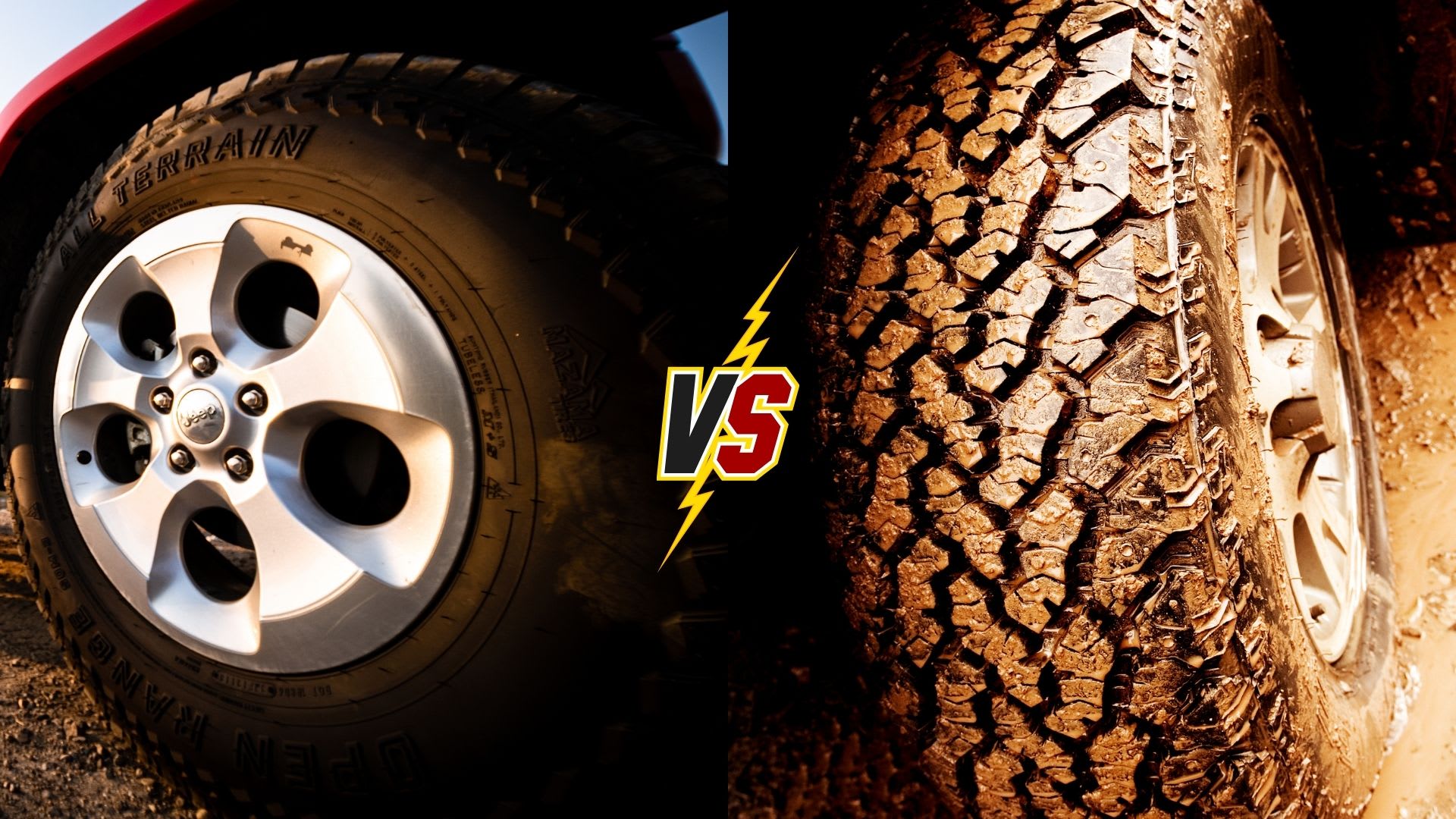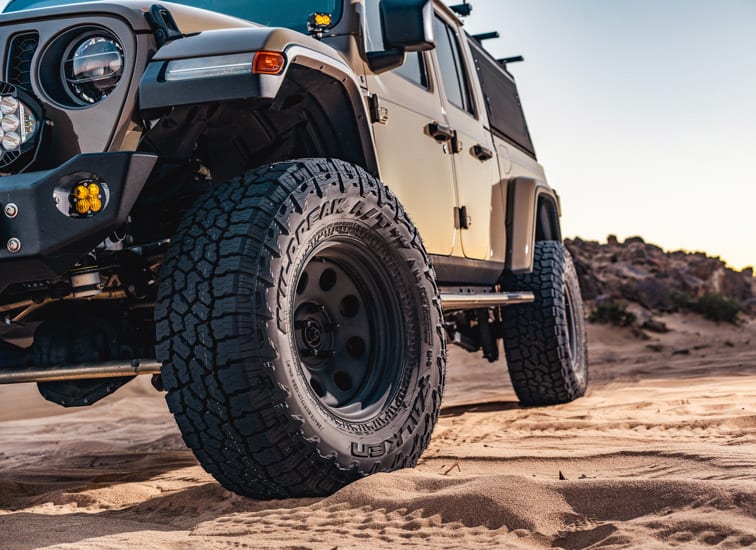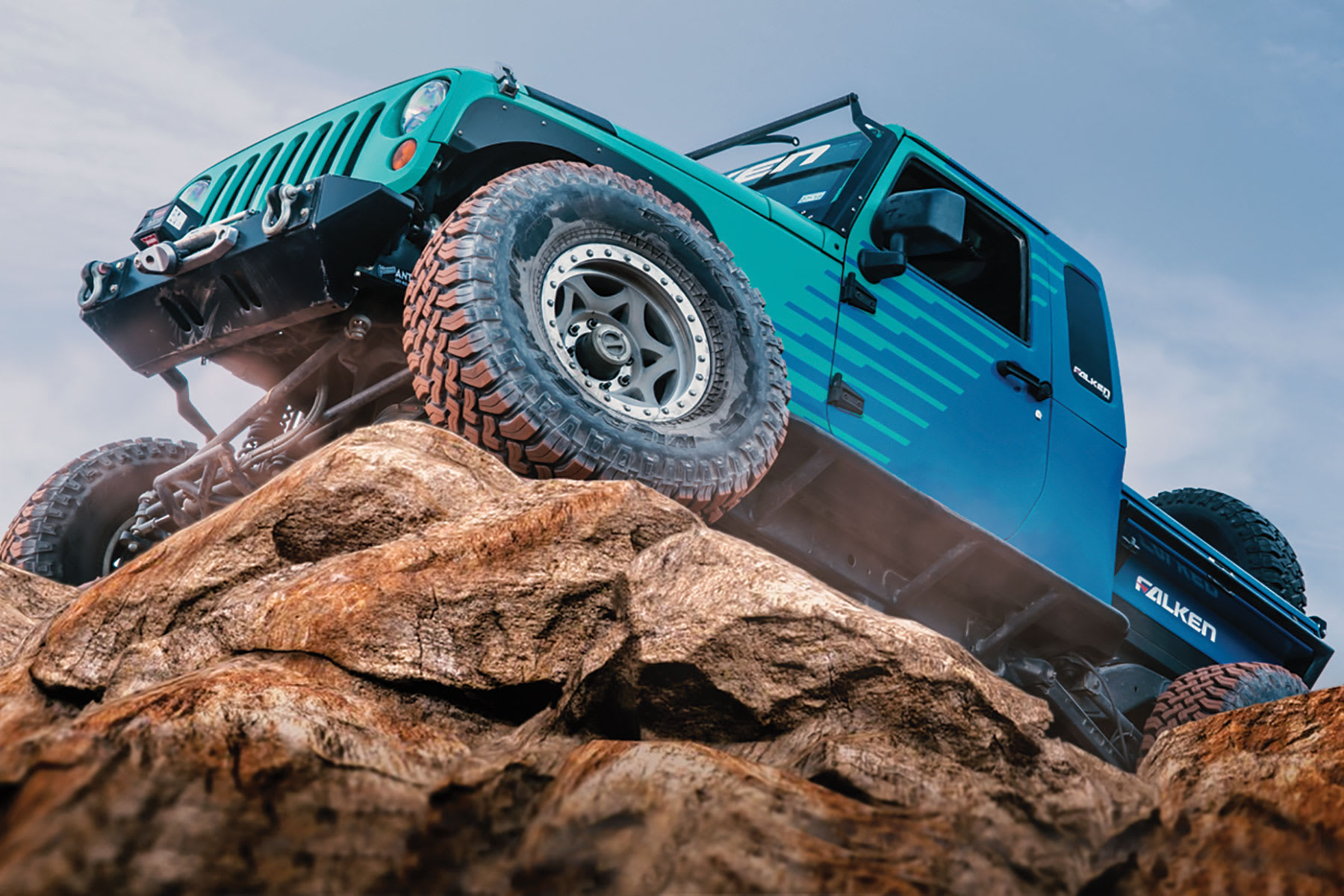Tire Buying Guides
Free shipping
Best price guarantee
Special pricing
Financing with Resolve
Easy returns

Choosing between all-terrain and mud tires represents one of the most important decisions for light truck and SUV owners who venture beyond pavement. Each tire type serves distinct purposes, with design characteristics that dramatically affect vehicle performance both on highways and trails.
Modern tire technology has blurred some traditional boundaries between these categories. Today's all-terrain tires deliver more off-road capability than ever before, while mud-terrain options have evolved to provide better on-road manners than their predecessors.
Understanding the fundamental differences between these tire types—from tread patterns to rubber compounds—helps drivers select the right option for their specific needs. The choice impacts everything from daily fuel economy to weekend trail performance, making proper tire selection essential for both safety and satisfaction.
What Are All-Terrain and Mud Tires?
All-Terrain Tires: The Versatile Choice
All-terrain tires bridge the gap between highway comfort and off-road capability through carefully engineered design compromises. These tires feature moderate tread patterns with smaller gaps between tread blocks, allowing them to maintain road contact while still providing traction on loose surfaces. The tread design typically incorporates interlocking patterns that work together to grip various terrains without creating excessive road noise.
The construction of all-terrain tires emphasizes durability through firmer rubber compounds that resist wear during highway driving. Manufacturers incorporate siping—thin grooves cut across tread blocks—to enhance wet weather performance and maintain flexibility in cold conditions. This combination of features allows all-terrain tires to deliver 45,000 to 65,000 miles of service life with proper maintenance, making them cost-effective for drivers who need versatility.
Mud Tires: Built for Extreme Off-Road
Mud-terrain tires abandon compromise in favor of maximum off-road traction. Their aggressive tread patterns feature large, widely-spaced lugs that bite into soft surfaces and shed debris effectively. The deep voids between tread blocks—often incorporating special kick-out bars—prevent mud and rocks from packing into the tire, maintaining traction even in challenging conditions.
These specialized tires utilize softer rubber compounds that conform to irregular surfaces, enhancing grip on rocks, roots, and other obstacles. Manufacturers reinforce sidewalls with extra plies and sometimes materials like DuPont Kevlar to resist punctures from sharp rocks and trail hazards. While this robust construction provides exceptional off-road performance, it typically limits tread life to 35,000 to 45,000 miles under normal use.
The design philosophy behind mud tires prioritizes function over refinement. Every aspect—from the aggressive shoulder lugs to the reinforced bead area—serves to maximize traction and durability in extreme conditions. This single-minded focus on off-road performance creates tires that excel where all-terrains might struggle, particularly in deep mud, loose dirt, and technical rock crawling situations.
How Do All-Terrain and Mud Tires Differ in Performance?
On-Road Performance
All-terrain tires shine on highways by balancing comfort and utility. With tread designs optimized for reduced noise, these tires deliver a smoother driving experience by minimizing vibration and road hum. The efficient tread layout also contributes to better fuel mileage compared to more aggressive tires, often achieving up to 1 MPG more. Their siping technology channels water away, offering reliable traction even in wet conditions.
Mud-terrain tires, designed with off-road adventures in mind, tend to produce more road noise due to their open tread patterns. The robust design necessary for off-road grip can lead to increased rolling resistance, slightly compromising fuel efficiency. While they handle wet roads adequately, they lack the precision of all-terrain tires in these conditions due to their focus on off-road performance.
Off-Road Capability
When tackling challenging terrains, mud-terrain tires take the lead. Their deep, widely spaced lugs are engineered to maintain grip in extreme environments such as thick mud and rocky trails. The tread design allows for self-cleaning, ejecting mud and debris to keep the surface clear for optimal traction. This makes them ideal for serious off-roaders who seek maximum control in rugged landscapes.
All-terrain tires, while less specialized, provide respectable performance across varied off-road conditions. They manage trails and gravel roads effectively, offering a balanced approach that suits lighter off-road excursions. Their design supports traction on compact surfaces and sandy areas, making them versatile enough for drivers who encounter a mix of terrains and need a reliable all-around performer.
When Should You Choose All-Terrain Tires?

Daily Driving Priorities
All-terrain tires are ideal for drivers whose vehicles predominantly navigate paved surfaces. Designed to enhance fuel economy, these tires help extend the distance covered per gallon, offering significant savings for those conscious of their fuel budget. Their construction ensures a smooth and quiet ride, making daily commutes and lengthy highway drives more enjoyable. Equipped to handle wet conditions, all-terrain tires excel in delivering dependable traction during rainy days and light snowfall. Recognizing the adaptability of all-terrain tires means understanding their capability to adjust to varied road conditions while maintaining optimal performance.
Moderate Off-Road Adventures
For drivers who embark on occasional off-road journeys yet primarily travel on highways, all-terrain tires provide the perfect blend of functionality. They effectively navigate through dirt roads, gravel paths, and mild trails, offering the necessary grip and stability for such terrains. When exploring sandy beaches or dunes, these tires perform admirably without excessive digging or slipping. Furthermore, if your driving routine involves winter conditions, all-terrain tires manage light snow with assurance, making them a practical choice for diverse environments and seasonal changes.
When Are Mud Tires the Right Choice?

Serious Off-Road Requirements
Mud tires are essential for those who spend considerable time on demanding trails. Their rugged tread designs offer superior grip in conditions where challenging terrains like deep mud and loose rock are frequent. These tires prioritize exceptional off-road traction over highway comfort, making them ideal for enthusiasts involved in off-road competitions or rock crawling. Their capability to conquer the harshest terrains provides a crucial advantage for adventurers who demand peak performance from their equipment.
Built to endure the toughest conditions, mud tires feature robust sidewalls that resist punctures from jagged rocks and debris. This durability ensures reliability when navigating rugged paths, where the terrain can quickly turn treacherous. When the goal is to overcome the most challenging obstacles without compromise, mud tires become the go-to choice for serious off-roaders.
Specific Terrain Challenges
In areas abundant with deep, sticky mud, mud tires provide the traction necessary for effective navigation. Their large voids and self-cleaning properties prevent mud accumulation, maintaining consistent grip. With the ability to handle creek crossings and wet environments, these tires are well-suited for waterlogged trails.
For drivers tackling loose, rocky terrain, mud tires offer stability and control with their ability to adapt to uneven surfaces. Reinforced sidewalls protect against potential punctures, ensuring confidence on rocky routes. In conditions where a self-cleaning tread design is paramount, mud tires excel, providing the dependability needed for adventurous off-road pursuits.
What Are the Cost Differences Between All-Terrain and Mud Tires?
Initial Purchase Price
All-terrain tires offer a cost-effective choice for drivers, generally priced lower than mud tires. Typically, each all-terrain tire falls within the range of $200 to $400, depending on factors like size and specific features. In contrast, mud tires tend to be more expensive, ranging from $300 to $500 per tire due to their specialized design and robust construction.
Pricing for both tire types can vary significantly based on brand, dimensions, and load capacity. Higher-end models with advanced features might be priced at a premium. It's crucial to select tires that align with your vehicle's requirements to ensure both cost-efficiency and reliable performance.
Long-Term Value Considerations
Assessing long-term value, all-terrain tires often prove advantageous by lasting longer and needing fewer replacements, making them a smart choice for routine driving conditions. Their design also contributes to improved fuel efficiency, which can result in noticeable savings over time.
Mud tires, while designed for rugged terrain, may require more frequent maintenance, such as additional rotations to preserve even tread wear. This necessity can lead to increased overall costs, emphasizing the importance of evaluating the total cost of ownership rather than focusing solely on the purchase price. Balancing the benefits with the financial implications ensures you select the right tire for your driving needs and budget.
How Do Weather Conditions Affect Your Choice?
Snow and Winter Performance
In snowy and icy conditions, all-terrain tires generally show better performance due to their design features. They have tighter tread patterns that prevent snow from building up, ensuring reliable traction on winter roads. Additionally, siping enhances grip on icy surfaces, offering a safer driving experience in colder months. While they manage light snow effectively, severe winter conditions might call for specialized winter tires, which are specifically crafted to handle freezing temperatures and heavy snowfall.
Mud-terrain tires, with their rugged tread patterns, can face challenges in packed snow and ice. The open design that performs well in mud may not maintain adequate contact with slick, icy roads, potentially reducing control. In regions where harsh winter weather is a regular occurrence, mud tires might not provide the consistent performance required, making them less suitable for those environments.
Rain and Wet Conditions
All-terrain tires excel in rainy conditions due to their sophisticated tread designs and siping. These features efficiently channel water away, minimizing the risk of hydroplaning on slick roads. The construction of all-terrain tires supports a stable ride, ensuring confident braking even during intense rain.
On the other hand, mud-terrain tires might struggle on wet highways. Their large, open tread blocks are not optimized for dispersing water, which can increase hydroplaning risks. This makes them less ideal for areas with frequent rain or consistently wet roads. Choosing the appropriate tire type involves considering your regional climate and typical weather, ensuring your selection aligns with safety and reliability throughout the year.
Making Your Final Tire Decision
Assess Your Driving Reality
Selecting the appropriate tire requires a keen understanding of how your vehicle is utilized. Begin by assessing the proportion of your driving that takes place on highways versus off-road trails. If your daily routine involves city commutes with occasional forays into nature, all-terrain tires may be more suitable.
Consider the specific conditions you frequently encounter, such as rain-soaked streets or uneven country paths. Evaluate your comfort level regarding road noise—important for those who frequently embark on long journeys. Fuel economy should also match your expectations, particularly if you're conscious of long-term fuel costs. Contemplate how often you'll need to replace tires, considering both their durability and your budgetary constraints.
Match Tires to Your Adventure Style
Aligning your tire choice with your intended driving adventures is crucial. For vehicles that handle everyday tasks while being ready for weekend excursions, all-terrain tires provide the versatility needed for diverse environments.
For dedicated off-road enthusiasts, where challenging landscapes are regularly tackled, mud tires offer the specialized performance required. These tires excel in delivering the grip and toughness necessary for demanding trails. If your driving includes a mix of both on-road and off-road conditions, hybrid tire options present a balanced solution. These tires incorporate elements from both categories, catering to varied driving scenarios.
Advancements in tire technology have enhanced the performance of both all-terrain and mud tires, offering better safety and durability. Whenever possible, test-driving vehicles equipped with different tire types can provide valuable insights into their handling and comfort, helping you make an informed decision tailored to your driving needs.
Your perfect tire choice depends on where your adventures take you and how you balance daily driving with off-road exploration. Whether you need the versatility of all-terrain tires for mixed driving or the extreme capability of mud tires for serious trail work, understanding these differences ensures you'll make the right investment for your vehicle and lifestyle. Ready to find your ideal tires? Shop for tires online and find the best deals with us, where we make tire buying simple and affordable.
Ready to find the perfect tires?
Search By